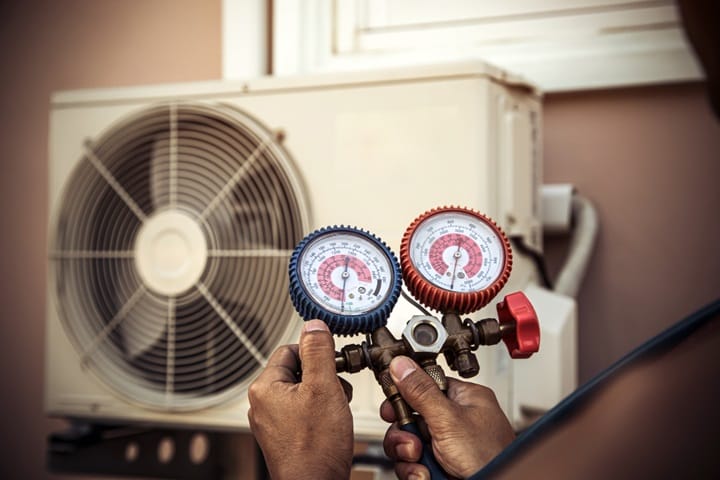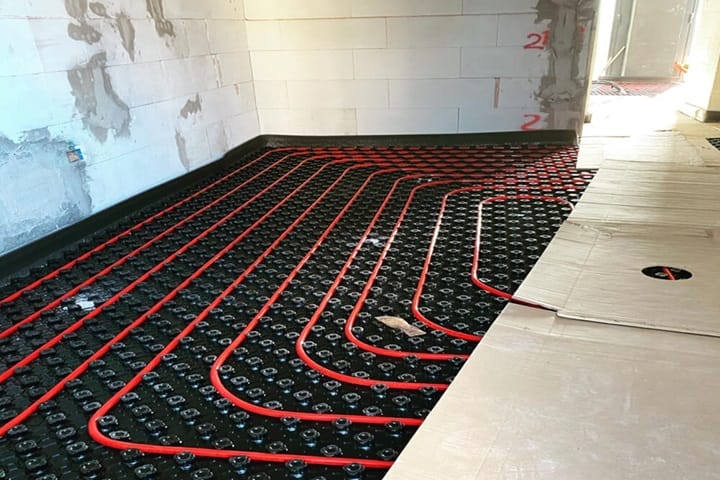Looking for an energy-efficient way to heat your home from the ground up? Pairing a heat pump with underfloor heating could be the answer.
This guide will explain how heat pump underfloor heating works, how they compare to traditional central heating systems, and why combining both technologies makes sense for modern homes. Whether you’re upgrading your system or building from scratch, we’ll walk you through how a heat source pump with an underfloor heating setup can work, the benefits it brings, and what to consider before getting started.
Key Points:
- Learn how heat pumps use air to heat your home
- Understand the difference between wet and electric underfloor heating
- Discover the key benefits of combining UFH with heat pumps
- Know what to plan for before installation (costs, insulation, permissions)
- How Does A Heat Pump Work?
- Understanding Heat Pump Efficiency
- How Does Underfloor Heating Work?
- Types of Underfloor Heating Systems
- Wet UFH Options
- Benefits of Combining Underfloor Heating with a Heat Pump
- What to Consider Before Installing a Heat Pump with Underfloor Heating
- Underfloor Heating Design Matters
- Insulating Your Home for Better Performance
- How Much Does Installation Cost and How Long Will It Take?
- Do I Need Planning Permission?
- Meet the Standards
- FAQs
- Sources
How Does A Heat Pump Work?
A heat source heat pump works by collecting warmth from the air outside and turning it into usable heat for your home. Even on colder days, there’s still energy in the air that can be used to warm your rooms and water. This is done using a refrigerant cycle that transfers heat into your system efficiently.
Here’s a breakdown of how it works:
- Air Intake: The heat pump pulls in air from outside.
- Evaporation: That air passes over an evaporator coil, where a refrigerant inside absorbs the heat. The refrigerant changes from a liquid to a gas as it warms up.
- Compression: This gas is then compressed, which increases its temperature further.
- Heat Exchange: The hot gas passes through a heat exchanger. The heat is transferred to your home’s water or heating system, and the refrigerant turns back into a liquid.
- Repeat Cycle: The process continues as needed to keep your home warm.
This setup works well with underfloor heating systems because both operate efficiently at lower temperatures. That means less energy is used overall, helping reduce bills and carbon emissions.
Understanding Heat Pump Efficiency

One of the main benefits of heat pumps is energy efficiency. For every unit of electricity used, a heat pump can generate multiple units of heat—making it more efficient than traditional gas boilers.
There are two common ways this efficiency is measured:
- COP (Coefficient of Performance): Shows how much heat is produced per unit of energy at a specific time.
- SCOP (Seasonal Coefficient of Performance): Averages that performance over the entire heating season.
The higher the COP or SCOP, the better the heat pump’s performance. This makes heat source heat pumps a smart choice for energy-conscious households.
How Does Underfloor Heating Work?
Underfloor heating systems work by spreading warmth through the floor, creating a comfortable temperature across the entire room. Instead of using radiators, which concentrate heat in one spot, this system distributes heat evenly across a larger surface area. This is particularly useful in a heat pump underfloor heating setup, where efficiency is higher at lower temperatures.
The heat produced by a heat pump flows into the underfloor heating system, which then transfers it through either cables or water pipes depending on the type you choose.
Types of Underfloor Heating Systems
There are two main kinds of underfloor heating: electric and wet.
- Electric Underfloor Heating Systems (Electric UFH): This system uses electric heating wires installed under your floor. When powered on, the wires warm up and release heat upwards into the room. It’s typically used for smaller areas or in renovation projects where floor height is limited.
- Wet Underfloor Heating Systems (Water UFH): This version uses warm water circulated through a series of flexible pipes under the floor. The pipes are connected to a heating source—such as a heat source heat pump underfloor heating system. Wet systems are often used for whole-house heating or new builds.
Wet UFH Options
Wet underfloor heating kits come in several formats, depending on your floor structure:
- Dual purpose underfloor heating kits: Exclusively provided by NOVAPRO, this low-profile heating system is made up of panels so that they can easily be added over existing floors with minimal disruption.
- Low profile wet underfloor heating: Pipes sit in panels with a thinner screed layer on top.
- Overlay underfloor heating: A straightforward solution for adding over existing concrete floors, floorboards, tiles, and hardwood flooring.
Each system has its advantages and can be matched to your home’s construction type or project scope.
Benefits of Combining Underfloor Heating with a Heat Pump
Underfloor heating is a perfect fit for heat pumps, allowing you to purchase a heat source heat pump underfloor heating combi that can be all the more beneficial for your establishment. That’s because both are most efficient when operating at lower temperatures. A typical heat source heat pump underfloor heating system runs between 35°C and 55°C, much cooler than a standard gas boiler.
Because underfloor heating covers a large surface area, it doesn’t need to run hot to make the room feel warm. This allows the heat pump to operate efficiently while still keeping your space comfortable.
Pairing the two systems together can result in:
- Lower running costs: Underfloor heating runs best at low flow temperatures, which is exactly how air source heat pumps are designed to work. Together, they form an efficient heating system that uses less energy compared to older, high-temperature setups like gas boilers. You still get a warm, cosy home—without using as much power to get there.
- Reduced energy usage: A properly designed heat source heat pump underfloor heating system can remove your need for gas entirely. Once your heating and hot water are handled by the heat pump and UFH, there’s no need to rely on fossil fuels. That means no more gas bills and more predictable energy costs moving forward.
- Consistent, even heat: Underfloor heating delivers warmth evenly across the whole room. There are no cold patches or areas that feel too hot. Heat rises gently from the ground, making the space feel comfortable throughout—even in larger or open-plan rooms.
- Fewer draughts or cold spots: Common household heating systems can leave cold spots or draughts echoing around the home; consistent underfloor heating eradicates these errors to deliver a favourable, comfortable temperature in every room, all the time.
- A more flexible layout with no radiators needed: With no bulky radiators to work around, you’re free to plan your furniture layout however you like. This is especially useful in modern homes where clean lines and open space are a priority. It also makes underfloor heating a great choice for kitchens, bathrooms, and extensions.
What to Consider Before Installing a Heat Pump with Underfloor Heating

Before going ahead with a heat pump underfloor heating system, there are a few things worth planning in advance. From proper pipe layout to insulation and permissions, getting the details right at the start will help your system run smoothly, save energy, and last longer.
Underfloor Heating Design Matters
When setting up underfloor heating, the layout of the pipework plays a key role in performance. The pipes need to be correctly spaced and mapped out to deliver even heat across the floor.
Here’s what a qualified installer will consider:
- The total pipe length required for the size of each room
- Even spacing between pipes to avoid cold spots
- A pipe layout that suits your room shape and floor type
For a heat source heat pump underfloor heating setup, this planning stage is especially important. Because the system works at lower temperatures, good heat distribution matters even more.
Insulating Your Home for Better Performance
To get the most out of your heating setup, your home needs to hold onto that warmth. Insulation boards for underfloor heating helps reduce the energy needed to keep rooms comfortable. Without it, even the best system will have to work harder than it should.
Areas where heat loss commonly occurs include:
- Windows – Upgrade to double or triple glazing to reduce draughts
- Roof – Fit or top up loft insulation to stop heat escaping upwards
- Walls – Add cavity or solid wall insulation to hold warmth inside
- Hallways – These environments can cause a dramatic shift in temperatures, as individuals switch between rooms, often raising the question, “why is my hallway so cold?”
- Floors – When fitting UFH, an insulation layer beneath the pipes helps direct the heat upward where it’s needed.
Good insulation supports heat pump underfloor heating by making your home easier to heat, meaning lower bills and better comfort.
How Much Does Installation Cost and How Long Will It Take?
Installing a heat pump takes longer than swapping out a gas boiler. The overall timeline depends on your home and what work is needed.
Factors that affect installation time include:
- Whether your property is a new build or an existing home.
- If system upgrades are needed (e.g., pipework or emitters).
- If you’re adding insulation or other energy-saving measures at the same time.
Do I Need Planning Permission?
In most cases, heat source heat pump underfloor heating installations don’t need planning permission because they fall under permitted development. However, always double-check with your local planning office if your home is:
- A listed building
- In a conservation area
- Located in an Area of Outstanding Natural Beauty (AONB)
Meet the Standards
To keep everything above board and running safely, your installer must follow:
- The manufacturer’s official installation guidelines
- Building Regulations for heating and plumbing systems
If you’re applying for government grants like the Boiler Upgrade Scheme, the work may also need to meet MCS certification standards. Confirming these early can help your installation go ahead without delays.
Explore our in-depth guides about different types of heat pumps with underfloor heating:
FAQs
How often does a heat pump need servicing when used with underfloor heating?
A heat pump should be serviced at least once a year to ensure it runs efficiently. This includes checking the refrigerant level, cleaning filters, and inspecting components. Regular maintenance helps extend the lifespan of your system and keep running costs low.
Is heat pump underfloor heating suitable for all types of flooring?
Most flooring types are compatible with UFH, including tile, stone, laminate, engineered wood, and vinyl. However, some floors—like thick carpets or solid hardwood—may reduce heat transfer. It’s best to check the flooring manufacturer’s UFH compatibility before installation.
Sources
GOV.UK. (2024) Areas of outstanding natural beauty (AONBs): designation and management. [online] Available at: https://www.gov.uk/guidance/areas-of-outstanding-natural-beauty-aonbs-designation-and-management [accessed 23/07/2025]
Energy Saving Trust. (2025) Boiler Upgrade Scheme. [online] Available at: https://energysavingtrust.org.uk/grants-and-loans/boiler-upgrade-scheme/ [accessed 23/07/2025]
